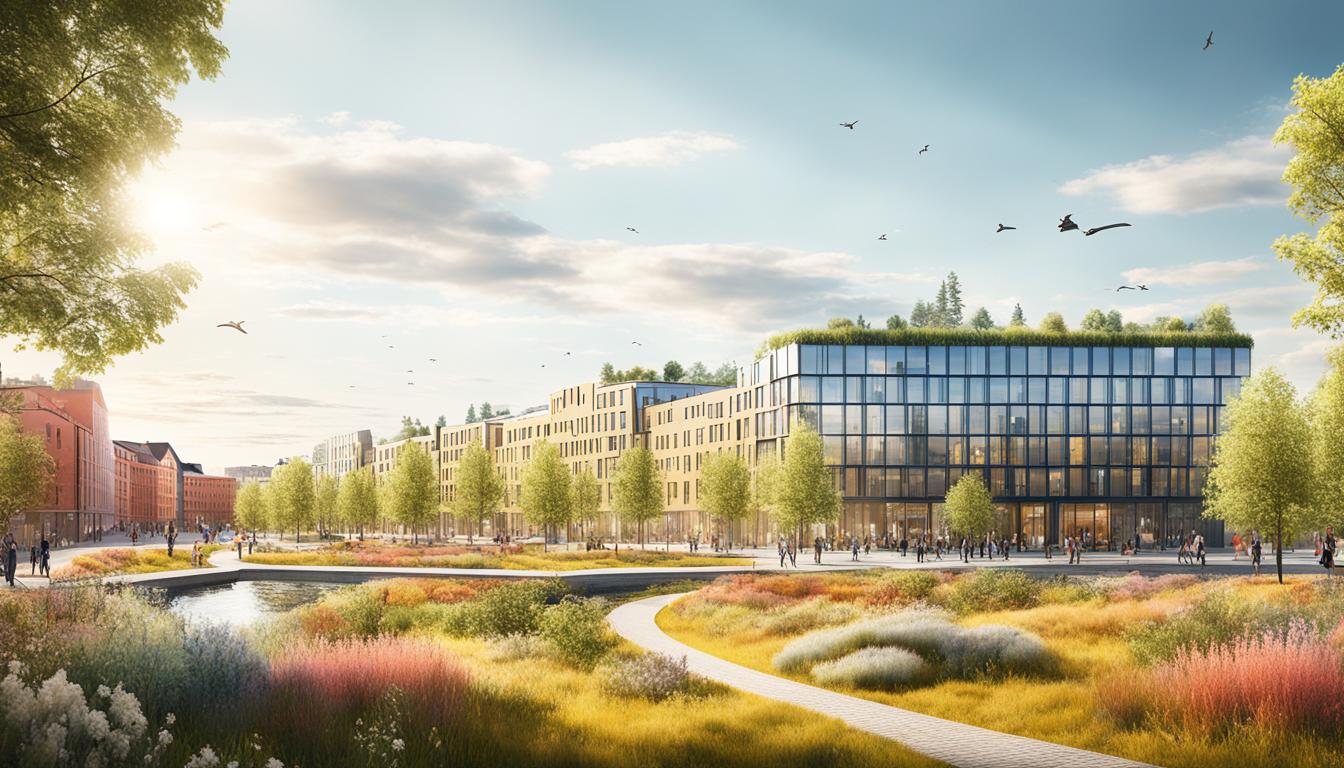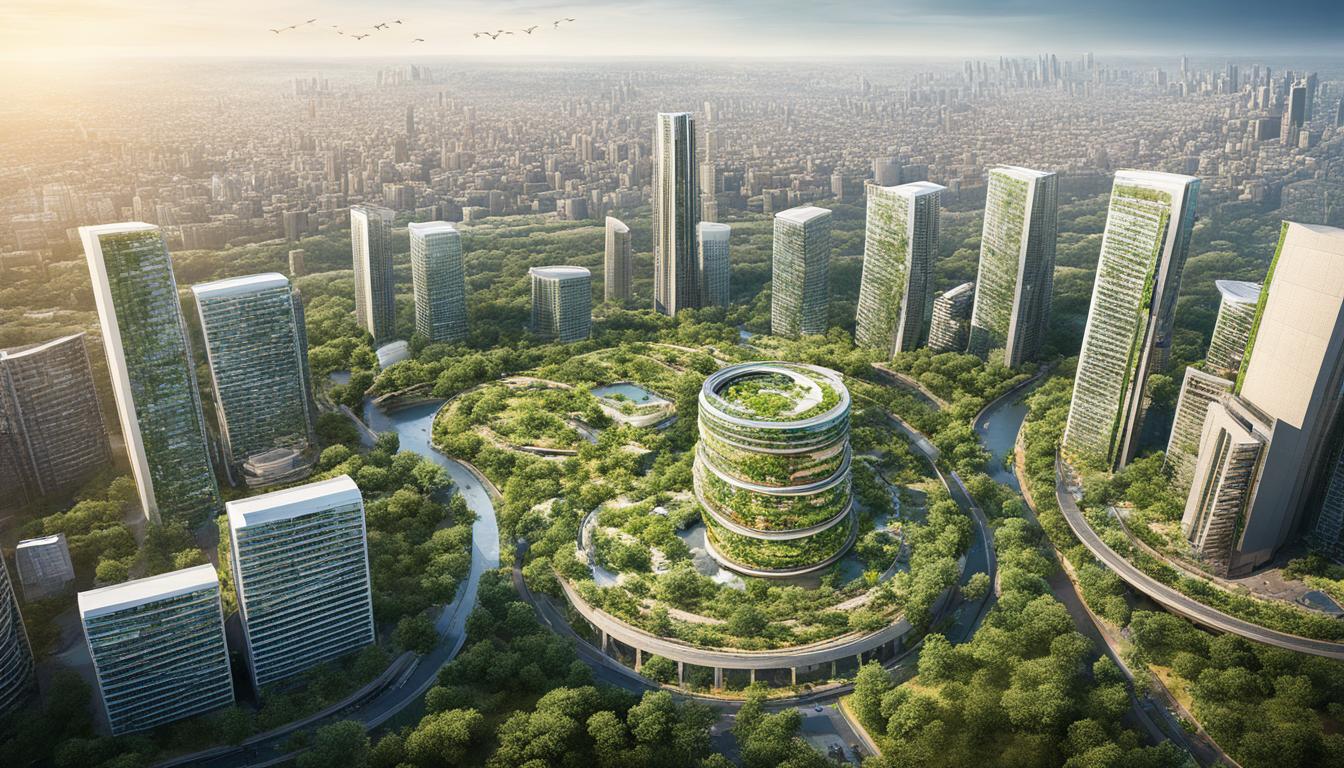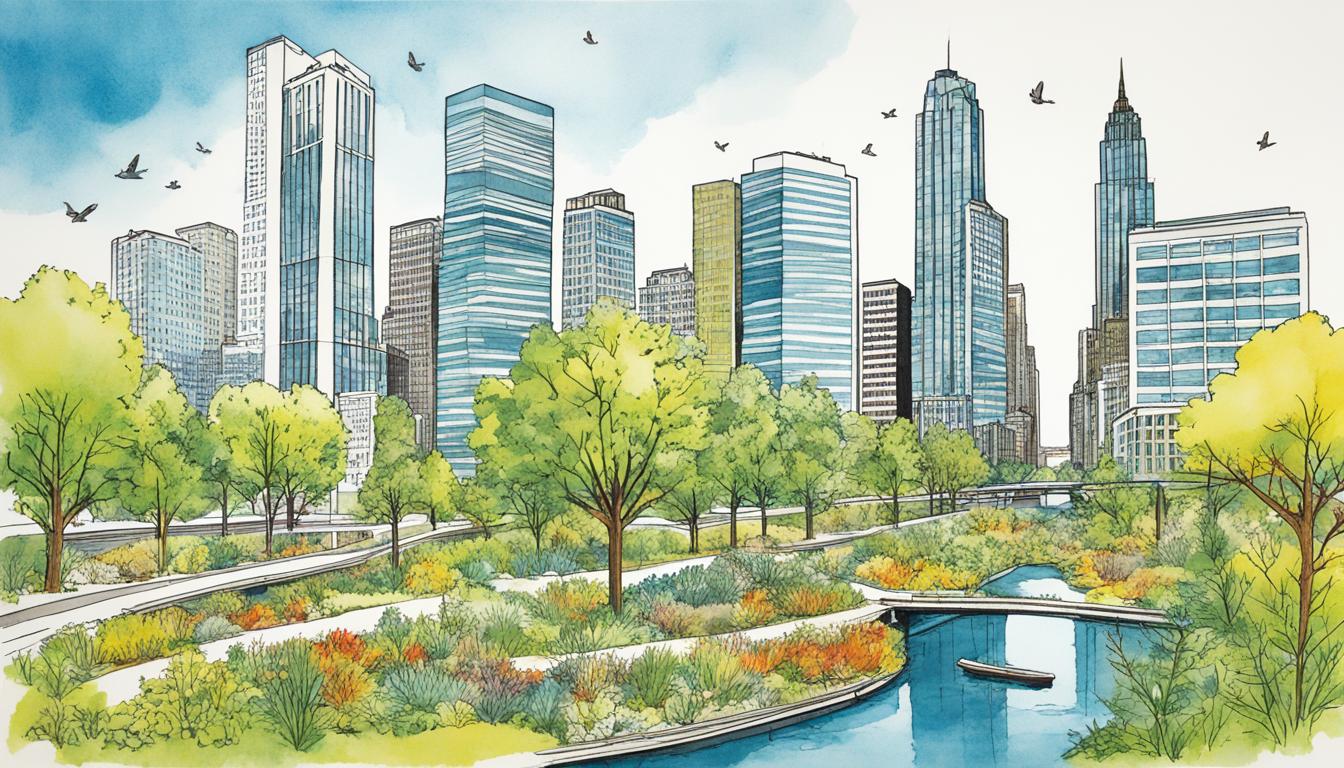France Biodiversity and the Built Environment
Did you know that France is home to more than 2,300 threatened species, including 660 strict endemic species?
When it comes to sustainable development and eco-friendly architecture, France has made remarkable strides in preserving biodiversity and creating a harmonious balance between the built environment and nature. From green urban planning to habitat restoration, France’s conservation initiatives serve as a global model for biodiversity management and environmental planning.
Key Takeaways:
- France is the 6th country hosting the largest number of endangered species.
- The country has a rich history of sustainable construction practices and eco-friendly architecture.
- Government initiatives and building labels promote sustainable urban development and green building certification.
- Preservation of biodiversity is a priority, especially in historical monuments and gardens.
- France’s commitment to sustainability has inspired other countries in their own green building programs and sustainable development initiatives.
Beginnings of Green Building in France
The green building movement in France traces its roots to the early adoption of sustainable construction practices and the prioritization of environmental design. Architects and builders recognized the importance of incorporating eco-friendly architecture to minimize the impact on the environment and promote long-term sustainability.
One of the key aspects of green building in France is the use of renewable building materials. From responsibly sourced timber to recycled materials, builders have embraced the concept of utilizing resources that have a minimal impact on the environment.
Passive design strategies have also played a significant role in France’s green building journey. By optimizing the building’s orientation, layout, and natural ventilation, architects have been able to reduce the reliance on mechanical systems and enhance energy efficiency.
The early focus on environmental design, renewable materials, and passive design elements laid the foundation for France’s impressive green building history, inspiring sustainable construction practices around the world.
“Sustainable construction practices are essential to create a built environment that minimizes its ecological footprint and contributes to a healthier planet.” – French architect, Pierre Desmoulins
Government Initiatives and Building Labels
France’s commitment to sustainability and eco-friendly architecture is evident in its government initiatives and building labels. The country has implemented various measures to promote sustainable urban development and green building certification.
One key initiative is the recognition of buildings with exceptional energy efficiency and the use of renewable energy sources through the THPE (Très Haute Performance Energétique) and THPE EnR (Très Haute Performance Energétique et Energies Renouvelables) labels. Buildings that meet the stringent criteria receive these labels, highlighting their commitment to environmentally conscious construction practices.
To encourage sustainable urban development, France emphasizes the creation of communities that prioritize green spaces, pedestrian-friendly infrastructure, and efficient public transportation systems. This approach ensures that cities and towns are designed with environmental sustainability in mind, promoting a healthier and greener living environment.
The Haute Qualité Environnementale (HQE) standard also plays a pivotal role in driving energy-efficient construction and waste reduction. This comprehensive certification system focuses on various aspects of sustainable building, such as energy and water use, waste management, indoor air quality, and ecological integration. Buildings that meet the HQE criteria receive certification, further incentivizing sustainable construction practices.
Overall, the combination of government initiatives and building labels in France demonstrates a strong commitment to promoting sustainable urban development and green building certification. These measures contribute to the country’s long-standing reputation for eco-friendly architecture and lay the foundation for a more sustainable and environmentally conscious built environment.
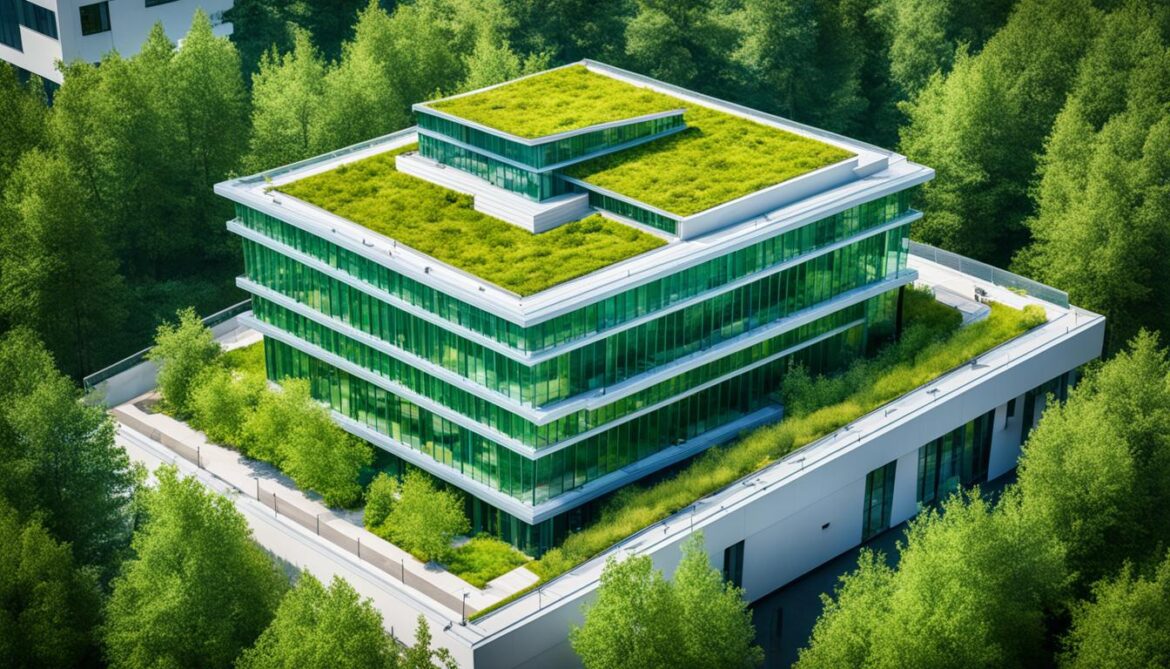
| Government Initiatives | Building Labels |
|---|---|
| Support for sustainable urban development | THPE (Très Haute Performance Energétique) |
| Promotion of green spaces and pedestrian-friendly infrastructure | THPE EnR (Très Haute Performance Energétique et Energies Renouvelables) |
| Focus on efficient public transportation systems | Haute Qualité Environnementale (HQE) standard |
| Certification based on energy efficiency, waste reduction, and ecological integration |
Preservation of Biodiversity in Historical Monuments
The Ministry of Culture in France is committed to preserving biodiversity in historical monuments and heritage sites. These sites not only hold cultural significance but also provide valuable habitats for various animal species. Many animals find suitable environments within these historical sites, using them for reproduction or hibernation. To protect endangered species and promote biodiversity conservation, France has implemented laws and a national biodiversity strategy.
One of the key measures taken to safeguard biodiversity in historical monuments is the establishment of partnership agreements with specialized associations. The League for the Protection of Birds (LPO) is one such association that collaborates with the Ministry of Culture to ensure the protection of protected species during restoration and maintenance phases.
Preserving biodiversity in historical monuments not only protects endangered species but also maintains the ecological balance within these sites. These efforts contribute to the overall conservation of biodiversity in France.

Integrating Biodiversity Conservation in Restoration of Built Heritage
France recognizes the importance of biodiversity conservation in the restoration of its cherished built heritage. The national biodiversity strategy aims to protect and preserve the country’s unique species while ensuring the careful restoration of historical sites. By integrating biodiversity conservation measures into restoration projects, France ensures that the imperatives of protection are met and the decline of certain species is avoided.
During the restoration process, specialized associations like the LPO (League for the Protection of Birds) collaborate closely to preserve and safeguard protected species. Their expertise and knowledge contribute to the successful implementation of restoration work that takes into account the needs of these species.
Parks and gardens that are classified as historical monuments are invaluable reservoirs of biodiversity. These green spaces are not only visually stunning but also support a diverse range of species. Management plans for these protected areas incorporate specific recommendations for biodiversity preservation.
“The preservation of biodiversity in the restoration of built heritage is a testament to France’s commitment to harmoniously blend the past and the present, ensuring the conservation of both our architectural heritage and our natural heritage.” – Jean-Pierre Dubois, President of the National Institute for Biodiversity Conservation
This integration of biodiversity conservation in the restoration of built heritage showcases France’s dedication to sustainable development and the preservation of species. It serves as a model for other countries seeking to balance conservation efforts with the restoration and maintenance of their historical monuments.
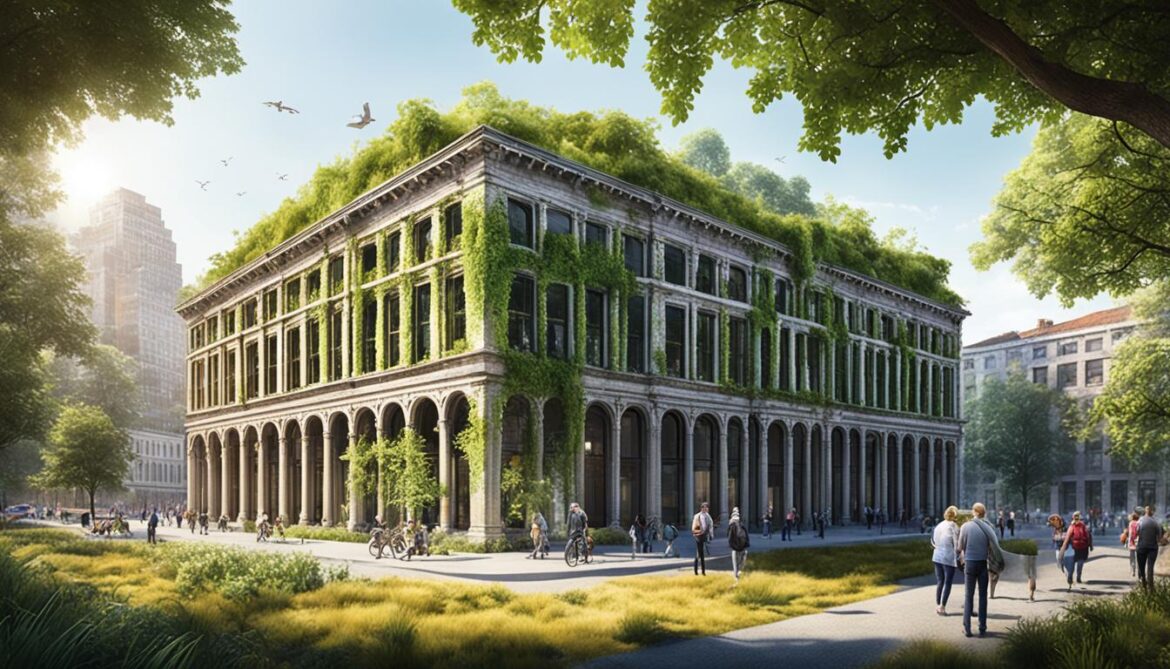
| Biodiversity Conservation Methods | Benefits |
|---|---|
| 1. Incorporating native plant species in landscaping | Enhances habitat for local fauna and promotes biodiversity |
| 2. Creating green corridors and wildlife-friendly structures | Facilitates movement and connectivity for species |
| 3. Managing invasive species | Protects native flora and fauna from harmful impacts |
| 4. Monitoring and conserving endangered species | Preserves biodiversity and ensures the survival of at-risk species |
Impact and Inspiration
France’s pioneering efforts in sustainable construction practices and green building certification have had a significant impact on global sustainability efforts. The country’s commitment to promoting environmentally friendly construction techniques has inspired countries worldwide to adopt similar regulations and standards.
One such country is Singapore, which has implemented the Green Mark scheme, rating buildings based on their environmental performance. Inspired by France’s green building history, Singapore aims to create a more sustainable and eco-friendly built environment.
Hong Kong is another region that has been inspired by France’s sustainable construction practices. It has introduced the BEAM Plus assessment tool to evaluate the sustainability performance of buildings. This tool aligns with France’s building labels and emphasizes the importance of energy efficiency and environmental consciousness.
The influence of France’s sustainable construction practices has also reached the European Union, where there is an increasing focus on sustainable development initiatives. France’s commitment to green building and biodiversity management has played a significant role in shaping global sustainability efforts.

Inspiration for Sustainable Construction
“France’s commitment to environmentally friendly construction sets a precedent for countries around the world. Its success in promoting sustainable practices has sparked a global movement towards more eco-conscious building methods.”
Global Sustainability Efforts
- Singapore implemented the Green Mark scheme to evaluate environmental performance.
- Hong Kong introduced the BEAM Plus assessment tool for sustainability evaluation.
- The European Union considers sustainable development initiatives.
| Country | Sustainable Construction Initiatives |
|---|---|
| Singapore | Implemented the Green Mark scheme |
| Hong Kong | Introduced the BEAM Plus assessment tool |
| European Union | Considering sustainable development initiatives |
Protection of Endangered Species and National Biodiversity Strategy
France, currently ranked as the 6th country in the world hosting the largest number of endangered species according to the International Union for Conservation of Nature (IUCN), is committed to the protection of these vulnerable creatures through robust laws and regulations. Central to this commitment is France’s national biodiversity strategy, which reflects its dedication to the Convention on Biological Diversity and aims to safeguard animal species and their natural habitats.
With over 2,300 species threatened in the country, including 660 strict endemic species, France recognizes the urgent need for action in preserving its biodiversity. Environmental policies and conservation efforts work together to ensure the survival and flourishing of endangered species.

| Protection Measures | Examples |
|---|---|
| Legal Framework | France has legislation in place to safeguard endangered species, such as the French Environmental Code and the Nature Protection Areas. |
| Habitat Restoration | Preservation efforts focus on restoring and conserving natural habitats critical to the survival of endangered species. |
| Sustainable Land Management | France promotes responsible land management practices to protect and maintain the diversity of its ecosystems. |
The national biodiversity strategy encompasses a wide range of initiatives, including habitat protection, species reintroduction programs, and raising public awareness about the importance of preserving biodiversity. By implementing comprehensive environmental policies, France seeks to secure a sustainable future for its precious wildlife.
“Preserving the biodiversity of our country is not only essential for the survival of endangered species but also for the overall health and balance of our ecosystems.”
Conservation Organizations
- French League for the Protection of Birds (LPO) – A leading association involved in the protection of endangered avian species and their habitats.
- National Museum of Natural History (MNHN) – Collaborates with researchers, scientists, and conservationists to study and preserve France’s biodiversity.
- The Wildlife Conservation Society (WCS) – Works to protect endangered species and their ecosystems around the world, including initiatives in France.
Through the collaboration of organizations, government entities, and individuals, France aims to fortify its efforts in protecting endangered species and conserving its national biodiversity. The collective commitment to environmental preservation forms a foundation for a sustainable and thriving ecosystem for future generations.
Conservation in Historical Monuments and Gardens
Historical monuments and gardens in France play a crucial role in the conservation of biodiversity. These sites are not only cultural treasures but also serve as habitats for a variety of plant and animal species.
The restoration of historical monuments goes beyond preserving architectural beauty; it also integrates the safeguarding of protected species. Partnership agreements are established with specialized associations like the League for the Protection of Birds (LPO) to ensure the protection and preservation of these species during the restoration process.
Parks and gardens protected under historical monument status act as true reservoirs of biodiversity. To further support biodiversity preservation, management plans are put in place. These plans incorporate recommendations on preserving biodiversity, sustainable water resource management, and soil conservation.
| Benefits of Conservation in Historical Monuments and Gardens: | Conservation Efforts |
|---|---|
| Biodiversity Preservation: | Historical monuments and gardens maintain and support a diverse range of plant and animal species, contributing to overall biodiversity preservation. |
| Habitat Protection: | These sites provide valuable habitats for numerous species, including rare and endangered ones, ensuring their survival and promoting healthy ecosystems. |
| Educational Value: | Historical monuments and gardens offer opportunities for educational programs and research, fostering a deeper understanding of the importance of biodiversity conservation. |
Preserving biodiversity in historical monuments and gardens not only enriches our cultural heritage but also contributes to the overall health and sustainability of ecosystems.

Influence on Other Countries
France’s commitment to sustainable construction practices and green building certification has had a significant influence on other countries. This influence can be seen in various green building programs and sustainable development initiatives implemented globally. Some notable examples include:
1. Singapore’s Green Mark Scheme
The Green Mark Scheme in Singapore is a rating system that assesses the environmental performance of buildings. It was inspired by France’s green building labels and aims to promote environmentally friendly construction practices. The scheme evaluates various aspects of a building’s design, construction, and operation, including energy efficiency, water conservation, and indoor environmental quality.
2. Hong Kong’s BEAM Plus Assessment Tool
Hong Kong has introduced the BEAM Plus assessment tool, which evaluates the sustainability performance of buildings. This tool draws inspiration from France’s Haute Qualité Environnementale (HQE) standard and focuses on energy efficiency, water conservation, waste management, and other sustainable design principles. The BEAM Plus assessment helps guide the development of environmentally responsible buildings in Hong Kong.
3. Sustainable Development Initiatives in the European Union
France’s commitment to sustainable development has influenced initiatives within the European Union. The EU is considering adopting sustainable development policies that align with France’s approach to promote environmentally conscious construction practices. The aim is to create a more sustainable built environment across member countries, with a focus on energy efficiency, renewable energy use, and overall environmental impact reduction.
France’s dedication to sustainable construction and green building programs has inspired global efforts towards creating a more sustainable future. By sharing its expertise and promoting environmentally friendly practices, France has influenced the development of green building initiatives and sustainable development strategies around the world.
| Country/Region | Green Building Program | Inspiration from France |
|---|---|---|
| Singapore | Green Mark Scheme | France’s green building labels |
| Hong Kong | BEAM Plus Assessment Tool | France’s Haute Qualité Environnementale (HQE) standard |
| European Union | Sustainable Development Initiatives | France’s sustainable development approach |
Economic Impact of Biodiversity
Biodiversity plays a vital role in the economic well-being of nations, including France. The preservation of biodiversity and the protection of natural resources like water and soil have significant economic benefits. France has recognized the economic value of ecosystem services and the importance of biodiversity for various sectors. By integrating biodiversity into development projects and establishing payment schemes for environmental services, France contributes to sustainable economic growth.
One of the key ways biodiversity supports the economy is through ecosystem services. These services include pollination, water purification, carbon sequestration, and soil fertility, among others. The economic value of these services has been estimated by France, highlighting their importance in sectors such as agriculture, forestry, and tourism.
Biodiversity is not only essential for the health of our planet, but it also provides tangible economic benefits. By protecting and preserving biodiversity, we can ensure sustained economic growth and development.
The integration of biodiversity in development projects is another significant factor in the economic impact. By incorporating biodiversity considerations into urban planning, infrastructure development, and land management, France promotes sustainable practices that align with ecological principles. This approach not only helps protect habitats and species but also enhances the long-term economic viability of these projects.
The Benefits of Biodiversity Integration:
- Enhanced resilience to climate change impacts
- Improved water and soil quality
- Enhanced ecosystem productivity
- Reduced economic losses from natural disasters
- Increased opportunities for eco-tourism and nature-based recreation
Furthermore, France’s establishment of payment schemes for environmental services encourages the conservation and sustainable use of biodiversity. These schemes provide incentives to landowners and communities to protect and steward ecosystems, recognizing the value of ecosystem services they provide. By compensating individuals and organizations for their role in protecting biodiversity, France ensures that sustainable practices are financially viable and recognized as essential contributions to the economy.
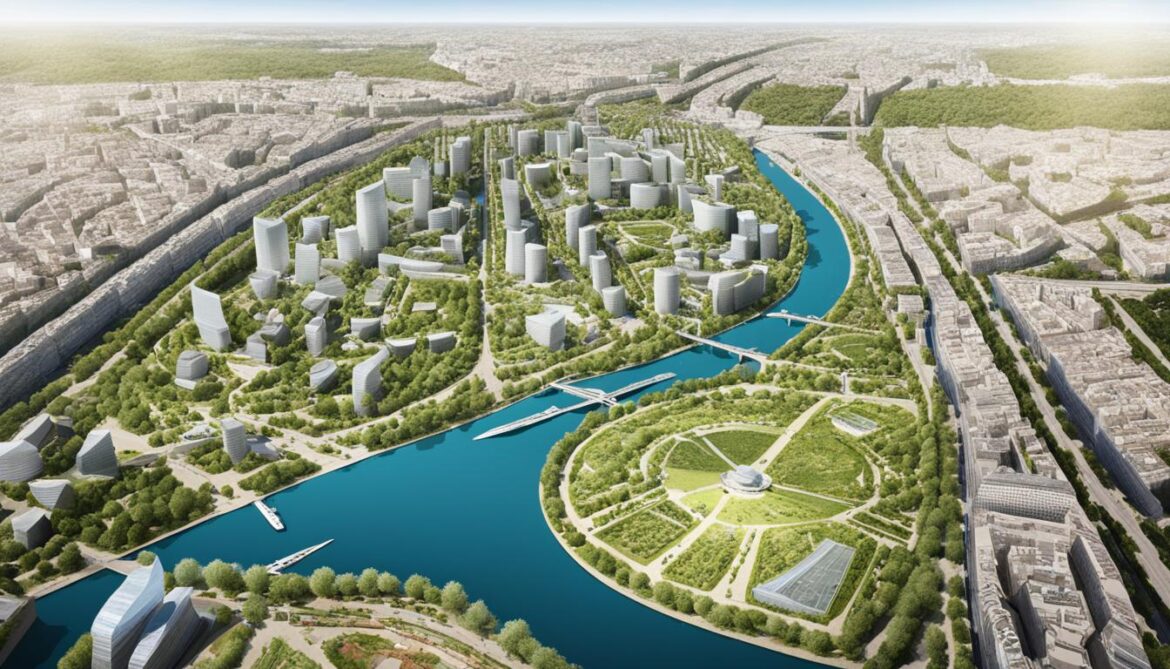
| Key Economic Impacts of Biodiversity |
|---|
| Enhanced productivity and profitability of agricultural systems |
| Increased revenue from nature-based tourism |
| Reduced costs associated with water treatment and purification |
| Enhanced resilience to climate change impacts |
| Improved long-term economic viability of development projects |
Understanding the economic impact of biodiversity is crucial for policymakers, businesses, and society as a whole. By recognizing the economic value of ecosystem services and integrating biodiversity into decision-making processes, France paves the way for sustainable economic development that prioritizes the preservation of biodiversity and the well-being of future generations.
Challenges and Future Perspectives
Despite the progress made in biodiversity conservation, there are still significant challenges that need to be addressed. France acknowledges these challenges and is committed to strengthening its efforts to preserve biodiversity for future generations. The country has identified various measures to tackle these challenges and ensure a sustainable future.
One of the key initiatives is the creation of nature reserves to protect vulnerable habitats and species. These protected areas serve as safe havens for biodiversity, allowing for the restoration and preservation of ecosystems. By establishing nature reserves, France aims to safeguard essential habitats and provide a conducive environment for species survival and recovery.
Additionally, France is focused on developing ecological networks. These networks connect different habitats and landscapes, enabling the movement and dispersal of species. By enhancing connectivity between natural areas, France aims to support genetic diversity and improve the resilience of ecosystems in the face of environmental change.
The integration of biodiversity into environmental policies, urban planning, and land management is also crucial for future conservation efforts. France recognizes the importance of incorporating biodiversity considerations into decision-making processes. By embedding biodiversity into these frameworks, France aims to ensure that conservation goals are prioritized and effectively implemented.
France’s commitment to biodiversity conservation extends beyond national borders. The country actively participates in international agreements and initiatives, contributing to global efforts in biodiversity preservation and sustainable development. Through collaborations and knowledge sharing, France seeks to enhance collective action and promote global awareness of the importance of biodiversity.
The preservation of biodiversity is essential for the well-being of our planet and future generations. France’s dedication to addressing the challenges and advancing conservation efforts sets a positive example for other countries to follow.
Prioritizing Biodiversity Conservation
France recognizes that biodiversity conservation is not only a matter of responsibility but also essential for maintaining the planet’s ecological balance and ensuring the well-being of ecosystems and human populations. With the implementation of measures such as the creation of nature reserves, development of ecological networks, and integration of biodiversity into policies and planning, France is paving the way for a sustainable future.
In summary, France’s commitment to biodiversity conservation and environmental policies demonstrates its dedication to safeguarding the natural world. By overcoming challenges, implementing innovative solutions, and fostering international collaboration, France aims to preserve biodiversity for future generations.
| Challenges | Future Perspectives |
|---|---|
| Loss of habitat | Creation of nature reserves |
| Species extinction | Development of ecological networks |
| Lack of biodiversity integration | Incorporation into environmental policies and planning |
| Global conservation efforts | Active participation in international agreements |
Conclusion
France’s commitment to biodiversity preservation and sustainable development is commendable. Through its innovative eco-friendly architecture and conservation initiatives, the country has established itself as a leader in creating a built environment that prioritizes environmental well-being. France’s rich history of sustainable construction practices has inspired other countries to follow suit, adopting similar regulations and standards.
The efforts made by France in green building and biodiversity management contribute to a more sustainable and environmentally conscious future. By implementing initiatives that promote sustainable development and eco-friendly architecture, France is paving the way for a greener future. The conservation of biodiversity is at the heart of these efforts, as France recognizes the crucial role it plays in creating a balanced and resilient ecosystem.
Through the integration of biodiversity preservation into the restoration of historical monuments and the management of parks and gardens, France showcases its commitment to protecting endangered species and their habitats. Additionally, the collaboration with specialized associations, such as the League for the Protection of Birds (LPO), ensures that conservation efforts are effective and impactful.
France’s dedication to sustainable development, eco-friendly architecture, and conservation initiatives sets an example for the global community. By prioritizing the well-being of the environment and embracing innovative practices, France serves as a beacon of inspiration for other nations striving for a more sustainable and environmentally friendly future.
FAQ
What is sustainable development?
Sustainable development refers to the practice of meeting current societal needs while ensuring the well-being of future generations and preserving natural resources. It involves finding a balance between economic growth, social equity, and environmental conservation.
What is eco-friendly architecture?
Eco-friendly architecture, also known as green architecture, focuses on designing and constructing buildings that have minimal negative impact on the environment. It incorporates sustainable materials, energy-efficient technologies, and design strategies that reduce energy consumption and waste production.
What are conservation initiatives?
Conservation initiatives are efforts undertaken to protect and preserve natural ecosystems, wildlife, and cultural heritage. These initiatives aim to maintain biodiversity, restore habitats, and promote sustainable land and resource management.
What is green urban planning?
Green urban planning involves designing cities and urban areas in a way that promotes sustainability and environmental consciousness. It focuses on creating green spaces, implementing efficient transportation systems, and reducing pollution and energy consumption in urban environments.
Why is biodiversity preservation important?
Biodiversity preservation is important because it ensures the survival of diverse plant and animal species. Biodiversity plays a crucial role in maintaining ecological balance, contributing to ecosystem resilience, and providing humans with essential resources and services.
What is habitat restoration?
Habitat restoration refers to the process of rehabilitating and improving ecosystems and natural habitats that have been damaged or degraded. It involves removing invasive species, reintroducing native plants and animals, and implementing management practices to restore ecological functions.
What is environmental planning?
Environmental planning involves considering the environmental aspects and impacts of development projects and land use decisions. It aims to integrate sustainability principles, minimize environmental harm, and promote the conservation of natural resources and ecosystems.
What is biodiversity management?
Biodiversity management encompasses the strategies and actions implemented to conserve and manage biodiversity. It includes measures such as protected area management, species-specific conservation programs, and sustainable land use practices to ensure the long-term survival of diverse species and ecosystems.
Source Links
- https://www.oecd-ilibrary.org/sites/9789264252714-12-en/index.html?itemId=/content/component/9789264252714-12-en
- https://constructive-voices.com/france-green-building-history/
- https://www.culture.gouv.fr/en/Thematic/Monuments-Sites/Historical-monuments-heritage-sites/Environmental-themes/Respect-for-biodiversity



